#john lambton
Text
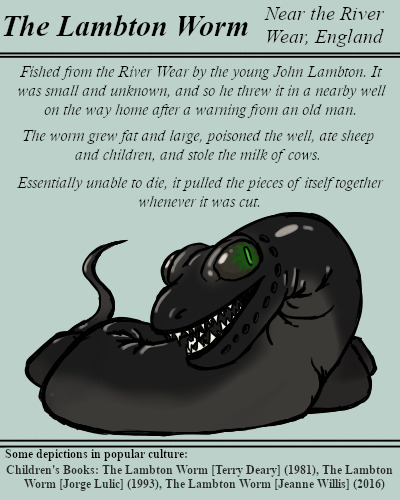
In the end, the worm was defeated in the river.
John Lambton donned armor covered in spearheads, cutting it apart when it attempted to coil itself around him. Then the strong running waters of the river prevented the worm from pulling itself back together.
#BriefBestiary#bestiary#digital art#fantasy#folklore#legend#myth#mythology#the lambton worm#lambton worm#john lambton#english mythology#english folklore#dragon#wyrm#worm#monster
8 notes
·
View notes
Text
Túrin Turambar 🤝 John Lambton
Heroes who use a river to their advantage when killing a dragon but find their victory immediately tainted by a family curse.
#túrin turambar#john lambton#coh#the lambton worm#I've already been on my coh/laidly worm bullshit#but now I'm going to subject you to CoH AUs of all of the Northumbrian worm myths
1 note
·
View note
Note
Do you have a fun fact in these trying times?
Tell me, friend, do you know the story of the Lambton Worm? If not, then Today You Learned about it.
[This story is in, like, ALL the dragon books.]
The story goes that some time in the ages of the Crusades, the town of Lambton was doing its usual Sunday business of going to Mass–except for the young heir to the Lambton Estate, John Lambton, who was going fishing instead. He got a few disapproving looks from people on the way to church, but he kept fishing because he was a rebel like that. He had trouble catching actual fish, but as Mass was wrapping up, he caught something!

A worm that looked like the Devil.
Okay, so ‘worm’ in those days can also mean a serpent, and Wikipedia describes it as something eel-like. Just… he picked up something on his fishing line that was limbless, not that big, but ugly as all getout. John Lambton was freaked out by this, and he chucked it in the local well. Deciding this was punishment for his non-churchgoing ways, Johnny grows up, trying to forget about the worm. When he grows a little older, he even takes the Cross and goes on Crusade as penance.
Except the worm survived. And it grew down in that well, poisoning the water with its venom or perhaps its general ugliness. The worm eventually grows large enough to slither out of the well and starts to eat things–small animals, mostly. Then it starts drinking cows’ milk (which is a bad thing to feed dragons if you don’t want them to grow bigger), and THEN it gets big enough to start eating cows and small children.
This, as you may realize, is A Problem.
The people of Lambton, and its lord, realize that they can placate the thing by offering it milk and cows, but it keeps growing bigger, and they try to get people to come kill it. And of course knights come along and try to kill this dragon worm thing. It doesn’t work, though. Maybe they hack off a piece, but it grows back, and the worm wraps itself around a man in armor and squeezes him to death.
Finally, John Lambton, heir to Lambton, comes back from Crusade. He realizes what’s going on, and knows that it’s a problem he started in the first place, so he has to fix it. Though he sees that no one’s had much luck in killing it. So he goes to a local wise woman, and she tells him that he can kill the Worm, but first he has to make a special suit of armor, one with spearheads fused all over it. Then, when he chops it to bits, he must dump the remains in the river. And THEN, after the deed is done, he must kill the first living thing he sees. Otherwise, the house of Lambton will be cursed for nine generations.
Well, Johnny Lamb commissions the suit of armor, and then he tells his dad to arrange that when he’s done the deed, he’ll blow a horn, and so then a hunting dog will be released and John will kill it.
Lambton faces the Worm, which of course, wraps around him to constrict him. But it doesn’t work! Because his armor is covered in spikes! And so the worm pierces itself on his armor! And he has enough room to start chopping this thing to pieces. Then he throws those in the river, where the pieces are swept away before they can put themselves back together.
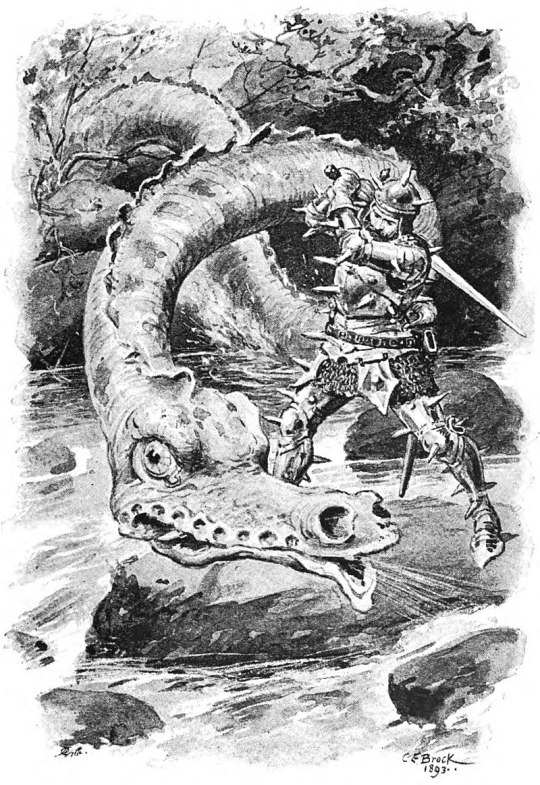
[C.E. Brock's illustration.]
Lambton blows the horn to signal victory. But ohes noes! His father is so happy that he forgets to release the hound, and runs to his son and kills him. John Lambton obviously cannot go through with killing his father, so he tries to kill the hound anyway, but it doesn’t work to avert the curse. For nine generations, none of the Lambton heirs died a peaceful death in their beds.
And that’s the story of the Lambton Worm, friendo!

[John Dickenson Batten's illustration]
43 notes
·
View notes
Text
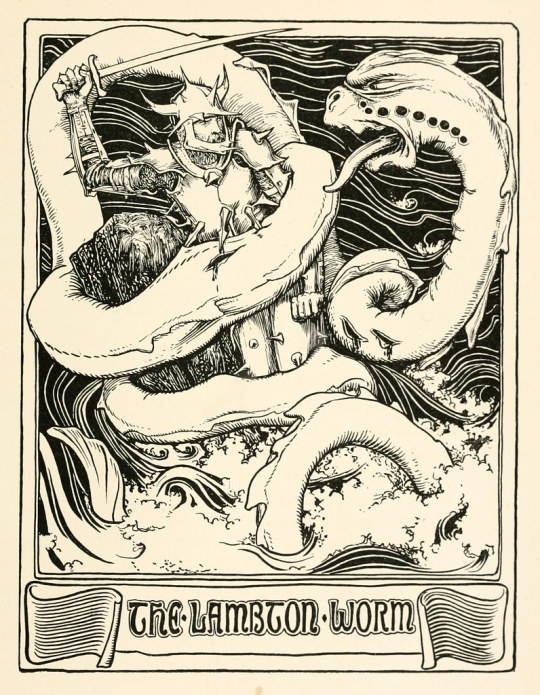
John D. Batten- The Lambton Worm, illustration from "More English Fairy Tales" 1894
via
15 notes
·
View notes
Text
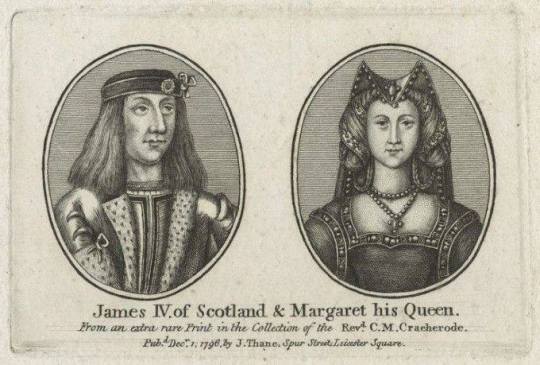
On May 28th 1503 a Papal Bull was signed by Pope Alexander VI confirming the marriage of King James IV and Margaret Tudor and the "Treaty of Everlasting Peace" between Scotland and England.
From an early age, Margaret was part of Henry VII’s negotiations for important marriages for his children and her betrothal to James IV of Scotland was made official by a treaty in 1502 even though discussions had been underway since 1496. Part of the delay was the wait for a papal dispensation because James’ great-grandmother was Joan Beaufort, sister of John Beaufort, who was the great-grandfather of Margaret Tudor. That made James IV and Margaret Tudor fourth cousins, which was within the prohibited degree. Patrick Hepburn, the Earl of Bothwell, acted as a proxy for James IV of Scotland for his betrothal to Margaret Tudor at Richmond in January 1502 before the couple was married in person.
James was dashing, accomplished, highly intelligent and interested in everything, James IV of Scots enjoyed himself with mistresses while manoeuvring to secure a politically useful bride, so the marriage was not just an "English thing".
Our King was 30, his bride was what has been described as "a dumpy 13 year old".
I'll dip into the "newspaper" of the day in Grafton's chronicle the following was written....
"Thus this fair lady was conveyed with a great company of lords, ladies, knights, esquires and gentlemen until she came to Berwick and from there to a village called Lambton Kirk in Scotland where the king with the flower of Scotland was ready to receive her, to whom the earl of Northumberland according to his commission delivered her." he went on "Then this lady was taken to the town of Edinburgh, and there the day after King James IV in the presence of all his nobility married the said princess, and feasted the English lords, and showed them jousts and other pastimes, very honourably, after the fashion of this rude country. When all things were done and finished according to their commission the earl of Surrey with all the English lords and ladies returned to their country, giving more praise to the manhood than to the good manner and nature of Scotland."
Not exactly flattering words!
The wedding finally took place for real (after several proxy marriages) on 8 August, 1503 at Holyrood House in Edinburgh. Margaret was officially crowned Queen in March 1504. The Scottish poet William Dunbar wrote several poems to Margaret around this time, including “The Thistle and the Rose”, “To Princess Margaret on her Arrival at Holyrood”
Now fayre, fayrest of every fayre,
Princes most plesant and preclare,
The lustyest one alyve that byne,
Welcum of Scotlond to be Quene!
Margaret was apparently homesick and not happy in her early days in Scotland, but the couple settled down to married life, there first child, James was born four years later, he died within the year, their second, a daughter fared little better she never survived a day. In 1309 another son only lived to be nine months old, such was the difficulties of trying to produce and heir, it's a wonder the human race survived, what with mortality rates being so high in the nobility, one only wonders how high it would have been for the ordinary citizen of Scotland?
Meanwhile Margarets father passed away and Henry VIII took the throne.
Margaret’s next child was born on April 11, 1512 at Linlithgow and named James. He survived childhood and was to become King James V and father of Mary.
As for "Treaty of Everlasting Peace" it lasted around 10 years, in the first few years of Henry VIII’s reign, the relations with Scotland became strained, and it eventually erupt in 1513, when Henry VIII went to France to wage war, this invoked The Auld Alliance and James IV, Henry VIII's brother-in-law marched his army into England only to be disastrously cut down on September 9th at Flodden Field, with too many of our Scottish Knights to count. The Queen gave birth to another son, Alexander the following April, but things would turn sour for her.
Margaret, then regent, remarried into the powerful Douglas family, the Scottish Parliament then removed her as Regent a pregnant Margaret fled Scotland in 1515, her sons were taken from her before she left. She was given lodgings by her brother at Harbottle Castle, where she gave birth to daughter, Margaret Douglas, who herself played a big part in Scottish history, becoming mother to Henry Stuart, Lord Darnley.
That wasn't the last we had seen of Margaret Tudor though, she returned to Scotland with a promise of safe conduct in 1517 but her marriage to Douglas was a disaster, he had taken a mistress while she was in England.
In 1524 Margaret, in alliance with the Earl of Arran, overthrew Albany's regency and her son was invested with his full royal authority. James V was still only 12, so Margaret was finally able to guide her son's government, but only for a short time since her husband, Archibald Douglas, came back on the scene and took control of the King and the government from 1525 to 1528. This would all come back to bite the ambitious Douglas family in the bum
In March 1527, Margaret was finally able to attain an annulment of her marriage to Angus from Pope Clement VII and by the next April she had married Henry Stewart, who had previously been her treasurer. Margaret's second husband then arrested her third husband on the grounds that he had married the Queen without approval. The situation was improved when James V was able to proclaim his majority as king (he was 16 at the time) and remove Angus and his family from power. James created his new stepfather Lord Methven and the Scottish parliament proclaimed Angus and his followers traitors. However, Angus had escaped to England and remained there until after James V's death.
Margaret's relationship with her son was relatively good, although she pushed for closer relations with England, where James preferred an alliance with France. In this, James won out and was married to Princess Madeleine, daughter of the King of France, in January 1537. The marriage did not last long because Madeleine died in July and was buried at Holyrood Abbey. After his first wife's death, James sought another bride from France, this time taking Marie de Guise (eldest child of the Claude, Duc de Guise) as a bride. By this same time, Margaret's own marriage had followed a path similar to her second one when Methven took a mistress and lived off his wife's money.
On October 18th 1541, Margaret Tudor died in Methven Castl. probably from a stroke. Margaret was buried at the Carthusian Abbey of St. John’s in Perth. Although Margaret's heirs were left out of the succession by Henry VIII and Edward VI, ultimately it would be Margaret's great-grandson James VI who would become king after the death of Elizabeth.
#scotland#scottish#england#english#the stewarts#the tudors#the thistle and the rose#history#marriage#peace tr
22 notes
·
View notes
Text
Lambton Worm

“The Serpent” © Rasmus Poulsen, accessed at his ArtStation here
[The Lambton Worm is a monster I have been considering off and on for literally a decade or more, and I’ve finally figured out how to do it mechanically. The legend of the Lambton Worm is one of the better known regional dragons in England, and one that I think is conventionally misinterpreted. A number of authors see it as a representation of the struggle between Christianity and paganism. I blame Bram Stoker for this take, as it appears in his atrocious The Lair of the White Worm. Yes, snakes and dragons do often represent the Devil, but the overarching theme in the story of the Lambton Worm is how much John Lambton sucks. He discovers the Worm when skipping church, throws it into a well, leaves his land for seven years, allowing the monster to grow up and start killing people, and finally fails in the sacrificial obligation to prevent his family line from being cursed for nine generations. So I interpret the Lambton Worm as more of a Fisher King style representation of the link between a lord and his land, and run with that interpretation in my flavor text below.]
Lambton Worm
CR 17 LE Dragon
This serpent is longer than a castle wall, with a horned head and bleary red eyes. It drools a foul liquid.
The Lambton Worm is a draconic serpent that punishes dereliction of duty. It emerges in lands where the local lords are callow and slothful, and ravages the land to make it represent its lord’s moral character. They eat livestock and children, damage farms and pollute water supplies, never enough to completely destroy a fiefdom but enough to make those living there miserable and sick. It then establishes itself as a surrogate lord, holding the people hostage in exchange for milk, meat and treasure. There is only one Lambton Worm, but it has said to have been born and reborn a dozen times in a dozen realms.
The Lambton Worm is large enough to level forests and buildings but can and does squeeze itself to fit into wells and caves. It enjoys drawing battles out in order to showcase its power, tearing a tree from the ground and wielding it like an enormous club in its prehensile tail. The beast’s jaws drip acidic venom, and it can vomit this out in lethal torrents. The worst quality of the Lambton Worm is its supernatural resilience; not only do they heal rapidly from wounds, they can even return to life once slain. Only by destroying or scattering the Worm’s body quickly can this rejuvenation be prevented.
The Lambton Worm is intelligent, but it rarely speaks—just enough to set the terms of its extortion. They may also boast that only those of noble heart and pure blood can slay them. This is a trap, as they delight in nothing else than to shatter social structures and delight in the death of kings and princes. Some scholars believe that the Lambton Worm owes its fealty to an archdevil, but the monster does not discuss its own origins.
Lambton Worm CR 17
XP 102,400
LE Colossal dragon (aquatic)
Init +5; Senses blindsense 120 ft., darkvision 60 ft., low-light vision, Perception +24, scent
Aura frightful presence (150 ft., Will DC 23)
Defense
AC 31, touch 3, flat-footed 30 (-8 size, +1 Dex, +2 natural)
hp 280 (17d12+170); fast healing 17
Fort +20, Ref +13, Will +17
DR 15/magic; Immune acid, curses, disease, poison; Resist cold 10, electricity 10, fire 10; SR 28
Defensive Abilities ferocity, rejuvenation
Offense
Speed 40 ft., swim 60 ft.
Melee greatclub +25/+20/+15/+10 (6d8+24), bite +23 (3d8+8 plus 2d8 acid plus poison) or bite +25 (3d8+16 plus 2d8 acid plus poison), tail slap +23 (4d6+24 plus grab)
Space 30 ft.; Reach 30 ft.
Special Attacks breath weapon (17d8 acid plus poison, 70 foot cone, Ref DC 28 half, 1d4 rounds), constrict (4d6+26), powerful blows (tail), smite nobility (6/day, +5 attack and AC, +17 damage)
Statistics
Str 42, Dex 13, Con 30, Int 10, Wis 25, Cha 21
Base Atk +17; CMB +41 (+45 grapple); CMD 52 (cannot be tripped)
Feats Blind-Fight, Cleave, Combat Reflexes, Great Cleave, Improved Critical (bite), Improved Initiative, Lightning Reflexes, Multiattack (B), Power Attack, Stand Still
Skills Climb +32, Diplomacy +22, Intimidate +22, Knowledge (nobility) +17, Perception +24, Sense Motive +24, Survival +24, Swim +32
Languages Common, Draconic, Infernal
SQ amphibious, compression
Ecology
Environment any hills or aquatic
Organization unique
Treasure standard
Special Abilities
Breath Weapon (Su) Any creature that fails its save against the Lambton Worm’s breath weapon is exposed to the creature’s poison.
Poison (Ex) Contact—bite or breath weapon; save Fort DC 28; duration 1/round for 4 rounds; effect 2d4 Con damage; cure 2 consecutive saves. The save DC is Constitution based.
Rejuvenation (Su) When the Lambton Worm is slain, it gains the effects of a breath of life spell (CL 17th) 1 round later. This effect does not occur if the Lambton Worm’s body has been scattered apart. The Lambton Worm can only use this ability once per day.
Smite Nobility (Su) This ability functions as a paladin’s smite evil class ability, except that it gains its benefits only for creatures that possess a noble title. The Lambton Worm’s class level is equal to its Hit Dice for this effect.
126 notes
·
View notes
Text
A dragon from Librum Prodigiosum! The Lambton Worm, from British mythology! Originating in a legend from county Durham- telling the story of John Lambton and his battle with the evil beast in the River Wear and his subsequent curse!

#digital art#digital illustration#fantasy#art#folklore#mythology#librum prodigiosum#monster#mythical creatures#creature#mythology art#artists on tumblr#dragon art#dragon#lambton worm#British mythology#mythologyart
26 notes
·
View notes
Text
Helen Grainger, 29 (Australia 2007)

Helen with her son Hayden.
After abortion was legalized in Australia, women began dying from the abortions that were falsely advertised to them as “safe and legal”. One of them was 29-year-old Helen Grainger.
Helen hadn’t wanted an abortion at all, but in April of 2007, Helen was told to have an abortion because she had health problems, including asthma and kidney disease. With her health conditions, she was not a candidate for an elective surgery. Abortion did not save her.
Helen underwent an abortion at Lambton Road Day Surgery. An inquest discovered that the abortionist had administered a medication called Kelflex, which Helen had a lethal allergy to. Her vital signs crashed within minutes of being taken to recovery. An inquest later discovered that the abortionist noticed Helen’s reaction but treated her incorrectly. He administered an overdose of adrenaline using a method that was inappropriate for her based on the severity of the reaction. According to the inquest, Helen was also dosed with approximately 20 times the amount she should have been given.
The incompetent overdose did nothing to help Helen and an ambulance had to be called. By the time the ambulance arrived, Helen’s chest was very tight and she was already in anaphylactic shock.
The ambulance took her to Newcastle's John Hunter Hospital, where she was put on life support. Her brain was severely damaged and she was taken off of the life support machines 3 days after the abortion that was supposedly for her own health.
Helen isn’t the only one to die from severe anaphylactic shock after being given a dangerous allergen during an abortion. Kelly Morse, an American with a Lidocaine allergy, was given 12 ccs of a Lidocaine solution by an abortion facility that allowed her to turn black and blue from oxygen deprivation. (This was after she told the facility’s staff about her allergy AND sent medical records documenting it.) There are also reports of anaphylactic shock induced by chemical abortion.
Abortion didn’t save Helen. If her health problems were making her pregnancy high-risk, she should have been carefully monitored and correctly treated in a hospital. A C-section or early induced labor for a high-risk pregnancy could have saved her and her baby.
https://www.dailytelegraph.com.au/bungled-to-death-by-poor-doctors/news-story/b9f0eebfe7a8bac68cbc1bf427e7492c?nk=82d506d21307f4f6af08c18c796aa4a9-1673645894
#tw murder#tw death#tw ab*rtion#tw abortion#abortion#pro life#pro choice#abortion debate#unsafe yet legal#justice for Helen
11 notes
·
View notes
Text
The Douai Martyrs is a name applied by the Catholic Church to 158 Catholic priests trained in the English College at Douai, France, who were executed by the English state between 1577 and 1680.[2]
History
Having completed their training at Douai, many returned to England and Wales with the intent to minister to the Catholic population. Under the Jesuits, etc. Act 1584 the presence of a priest within the realm was considered high treason. Missionaries from Douai were looked upon as a papal agents intent on overthrowing the queen. Many were arrested under charges of treason and conspiracy, resulting in torture and execution. In total, 158 members of Douai College were martyred between the years 1577 and 1680.[1] The first was Cuthbert Mayne, executed at Launceston, Cornwall on the 29 November 1577. [3] The last was Thomas Thwing, hanged, drawn, and quartered at York in October 1680.[4] Each time the news of another execution reached the College, a Solemn Mass of thanksgiving was sung.
Many people risked their lives during this period by assisting them, which was also prohibited under the Act. A number of the "seminary priests" from Douai were executed at a three-sided gallows at Tyburn near the present-day Marble Arch. A plaque to the "Catholic martyrs" executed at Tyburn in the period 1535 - 1681 is located at 8 Hyde Park Place, the site of Tyburn convent.[5]
They were beatified between 1886, 1929 and 1987, and only 20 were canonized in 1970. Today, British Catholic dioceses celebrate their feast day on 29 October.[1]
Bl Alexander Crow
Bl Anthony Middleton
Bl Antony Page
Bl Christopher Bales
Bl Christopher Buxton
Bl Christopher Robinson
Bl Christopher Wharton
Bl Edmund Catherick
Bl Edmund Duke
Bl Edmund Sykes
Bl Edward Bamber
Bl Edward Burden
Bl Edward James
Bl Edward Jones
Bl Edward Osbaldeston
Bl Edward Stransham
Bl Edward Thwing
Bl Edward Waterson
Bl Everald Hanse
Bl Francis Ingleby
Bl Francis Page
Bl George Beesley
Bl George Gervase
Bl George Haydock
Bl George Napper
Bl George Nichols
Bl Henry Heath
Bl Hugh Green
Bl Hugh More
Bl Hugh Taylor
Bl James Claxton
Bl James Fenn
Bl James Thompson
Bl John Adams
Bl John Amias
Bl John Bodey
Bl John Cornelius
Bl John Duckett
Bl John Hambley
Bl John Hogg
Bl John Ingram
Bl John Lockwood
Bl John Lowe
Bl John Munden
Bl John Nelson
Bl John Nutter
Bl John Pibush
Bl John Robinson
Bl John Sandys
Bl John Shert
Bl John Slade
Bl John Sugar
Bl John Thules
Bl Joseph Lambton
Bl Lawrence Richardson
Bl Mark Barkworth
Bl Matthew Flathers
Bl Montfort Scott
Bl Nicholas Garlick
Bl Nicholas Postgate
Bl Nicholas Woodfen
Bl Peter Snow
Bl Ralph Crockett
Bl Richard Hill
Bl Richard Holiday
Bl Richard Kirkman
Bl Richard Newport
Bl Richard Sergeant
Bl Richard Simpson
Bl Richard Thirkeld
Bl Richard Yaxley
Bl Robert Anderton
Bl Robert Dalby
Bl Robert Dibdale
Bl Robert Drury
Bl Robert Johnson
Bl Robert Ludlam
Bl Robert Nutter
Bl Robert Sutton
Bl Robert Thorpe
Bl Robert Wilcox
Bl Roger Cadwallador
Bl Roger Filcock
Bl Stephen Rowsham
Bl Thomas Alfield
Bl Thomas Atkinson
Bl Thomas Belson
Bl Thomas Cottam
Bl Thomas Maxfield
Bl Thomas Palaser
Bl Thomas Pilchard
Bl Thomas Pormort
Bl Thomas Reynolds
Bl Thomas Sherwood
Bl Thomas Somers
Bl Thomas Sprott
Bl Thomas Thwing
Bl Thomas Tunstal
Bl Thurstan Hunt
Bl William Andleby
Bl William Davies
Bl William Filby
Bl William Harrington
Bl William Hart
Bl William Hartley
Bl William Lacey
Bl William Marsden
Bl William Patenson
Bl William Southerne
Bl William Spenser
Bl William Thomson
Bl William Ward
Bl William Way
St Alban Bartholomew Roe
St Alexander Briant
St Ambrose Edward Barlow
St Cuthbert Mayne
St Edmund Arrowsmith
St Edmund Campion
St Edmund Gennings
St Eustace White
St Henry Morse
St Henry Walpole
St John Almond
St John Boste
St John Kemble
St John Payne
St John Southworth
St John Wall
St Luke Kirby
St Ralph Sherwin
St Robert Southwell
Ven Edward Morgan
Ven Thomas Tichborne
Bl Alexander Rawlins
Bl Edward Campion
Francis Dickinson
James Bird
James Harrison
John Finglow
John Goodman
John Hewitt
Matthias Harrison
Miles Gerard
St Polydore Plasden
Richard Horner
Robert Leigh
Robert Morton
Robert Watkinson
Roger Dickinson
Bl Thomas Felton
Bl Thomas Ford
Thomas Hemerford
Thomas Holford
William Dean
William Freeman
Bl William Gunter
Bl William Richardson
[+]
2 notes
·
View notes
Photo

Illustration of the Lambton Worm by C. E. Brock from English Fairy and Other Folk Tales.
I’ve been thinking about this a lot since reading Poli and Stoneman’s 2020 paper about the link between fossil club mosses from ancient coal swamps and dragon lore.
Looking deeper into a few tales reveals their relationships
to the plant fossils’ appearance as well as their locations. Ac-
cording to lore, John Lambton yanks the Lambton worm
from the Wear River on the end of a fishing line and flings it
into a well, where it reaches enormous size [38]. Years later,
pieces of the worm are hacked off in an effort to kill it, but it
regenerates these parts and lives on. Lambton’s worm grows
so large that it can wrap itself around a hill seven times, a
feat that causes a (still-visible) circular indentation around
Worm Hill, located near a documented fossil site. Eventu-
ally, Lambton hacks the worm to pieces, which float down
the Wear before the worm is finally torn completely apart,
having impaled itself on Lambton’s armor. Note that Lamb-
ton’s estate sits at the site of lead, coal and limestone mines
that have operated for centuries. Interestingly, up until the
seventeenth century, coal was believed to be a living thing
with “special seeds for its reproduction and growth under
the ground” [39]. Could the pieces of the Lambton worm
that washed down the Wear River have been the coal-black,
scaly fossils of Lepidodendron?
https://direct.mit.edu/leon/article/53/1/50/46847/Drawing-New-Boundaries-Finding-the-Origins-of
3 notes
·
View notes
Text
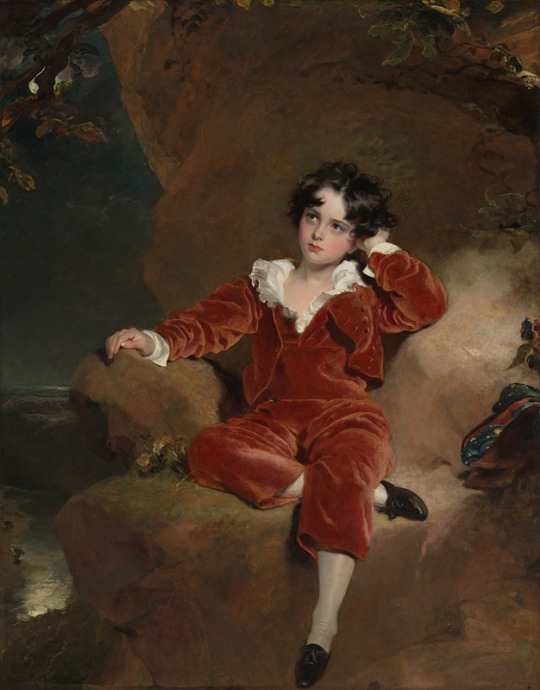
Título completo: Retrato de Charles William Lambton ('El niño de rojo')
Artista: Sir Thomas Lawrence
Fechas de artistas: 1769 - 1830
Fecha de realización: 1825
Medio y soporte: Óleo sobre lienzo
Dimensiones: 140,5 × 110,6 cm
crédito de adquisición: Comprado con el apoyo de American Friends of the National Gallery, Estate of Miss Gillian Cleaver, Art Fund (con una contribución de Wolfson Foundation), The Al Thani Collection Foundation, The Manny and Brigitta Davidson Charitable Foundation, Mr William Sharpe, y The Society of Dilettanti Charitable Trust, 2021
Numero de inventario: NG6692
Este retrato de Charles William Lambton, de seis o siete años, fue encargado por el padre del niño, John George Lambton, primer conde de Durham, político whig y diputado del condado de Durham. Conocido popularmente como The Red Boy , permaneció en la familia Lambton hasta que fue adquirido por la National Gallery en 2021. Es reconocido como una de las obras maestras de Thomas Lawrence y, un signo de la perdurable popularidad de la imagen fue la primera pintura en ser reproducido en un sello postal británico en 1967.
Sentado en un promontorio con vistas a un mar iluminado por la luna, Lawrence retrata a Lambton como un niño vagabundo, perdido en la contemplación del sublime poder de la naturaleza. Las flores que se abren junto a él simbolizan su corta edad. Está al comienzo de su viaje por la vida, aunque esto se interrumpió: murió de tuberculosis con solo trece años. Lawrence puede haberse inspirado en la obra de Lord Byron o en el poema de William Wordsworth There was a Boy (1798).
A diferencia del famoso retrato de Gainsborough, The Blue Boy (1770, The Huntington Art Museum, San Marino) que viste un traje de 'Van Dyck' del siglo XVII, The Red Boy está vestido con la moda infantil contemporánea de ropa holgada. Varios de los jóvenes modelos de Lawrence usan estos "trajes de esqueleto" de terciopelo rojo que eran más espaciosos y mejores para jugar al aire libre y que, en 1800, habían reemplazado el vestido de Van Dyck para los niños de familias ricas.
Información e imagen de la web de la National Gallery de Londres.
3 notes
·
View notes
Note
Are the Ninki Nanka, Jabberwocky and/or Jabberwocky in Dracones Mundi?
Ninki Nanka is in a 'maybe' pile, as in it's got as far as my "I have notes about it" but not as far as "I have written a detailed chapter about it". At this point my 'maybe' pile is my 'probably not' pile, as I aim to finish this project as soon as I can - the reason I haven't done more on Ninki Ninka is I cannot find very many resources on it.
The Jabberwock, as far as I am aware, was invented purely by Lewis Carroll, and I tend not to put direct fan-dragons in Dracones Mundi itself - with the exception of maybe a luck dragon inspired by Michael Ende's Neverending Story, although I might just have a throwaway line saying that leucistic stollenwyrms (catlike dragons from Europe) can be called 'luck dragons' (luck dragons were white/pink/pearlescent dragons with leoline faces in the book, so a white dragon with a catlike face may be similar enough? Die Unendlichegeschichte is a German story so stollenwyrms/tatzelwyrms would tie into that).
The Jabberwock poem may have been based on legends of the Sockburn Wyrm and the Lambton Wyrm (both 'local legends' for me as I'm from the north of England), and I have included those wyrms in Dragones Mundi already (English Groundwyrm being a subspecies of European Lindwyrm).
The Jabberwocky Poem starts thus:
Twas brillig, and the slithy toves
Did gyre and gimble in the wabe;
All mimsy were the borogoves,
And the mome raths outgrabe.
Which, according to this website (which is better at analysing language than I am!) means it was boiling, and the lithe badgerlike animals in the ground were writhing and scratching around - this could mean that the jabberwock itself was poisoning the land in a similar way to a basilisk of legend.
Aside from this, we know the jabberwock burbles (dragons in Dracones Mundi can rumble, so I imagine burbling is an option too!) has 'eyes aflame' (dragons in my book have eyeshine) and jaws that bite (classic for crocodylomorphs). The line 'claws which catch' gives me pause, as dragon paws in Dracones Mundi are not very dexterous. The wyverns have paws which can grab branches and perhaps grab prey, but most of my dragons have very crocodylian paws, made for walking, digging and paddling moreso than 'catching'. A jabberwock in Dracones Mundi would therefore either be a lindwyrm (to bring the poem back to it's inspirations) or a wyvern (so it can have 'claws that catch').
The very famous John Tenniel illustration of the jabberwock gives it the '4 legs 2 wings' configuration of a firedrake, but due to the un-crocodylomorph' body stance and rodent-like teeth, it would not fit into the same family as other firedrakes in the project.
3 notes
·
View notes
Text
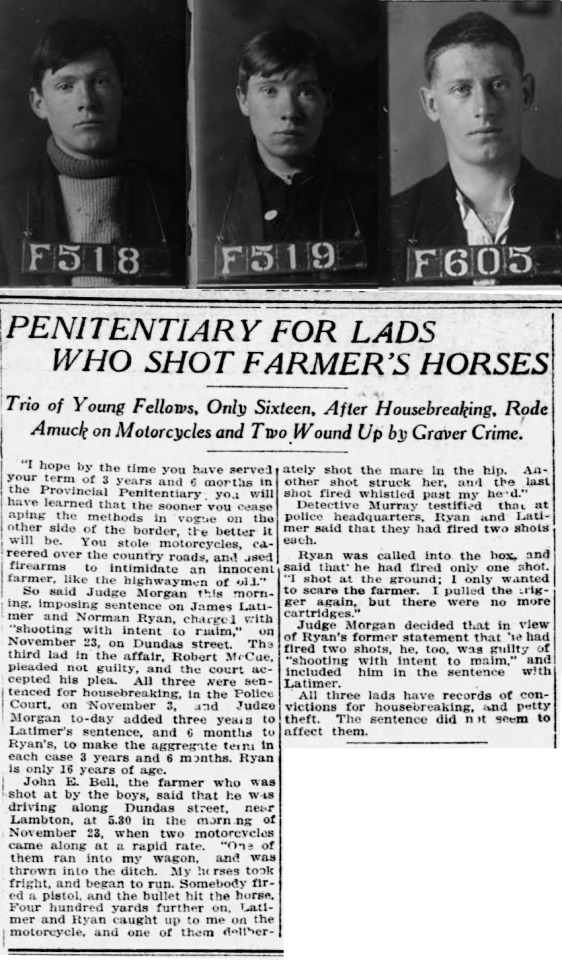
"PENITENTIARY FOR LADS WHO SHOT FARMER'S HORSES," Toronto Star. December 13, 1912. Page 29.
---
Trio of Young Fellows, Only Sixteen, After Housebreaking, Rode Amuck on Motorcycles and Two Wound Up by Graver Crime.
----
"I hope by the time you have served your term of 3 years and 6 months in the Provincial Penitentiary, you will have learned that the sooner you cease aping the methods in vogue on other side of the border, the better will be. You stole motorcycles, raced over the country roads, and used firearms to intimidate an innocent farmer, like the highwaymen of old."
ately shot the mare in the hip. An other shot struck her, and the last
So said Judge Morgan this morning, imposing sentence on James Latimer [pictured, right] and Norman Ryan, [pictured, left] charged with "shooting with intent to maim," on November 23, on Dundas street. The third lad in the affair, Robert McCue, [pictured centre] pleaded not guilty, and the court accepted his plea. All three were sentenced for housebreaking, in the Police Court, on November 3, and Judge Morgan to-day added three years to Latimer's sentence, and 6 months to Ryan's, to make the aggregate terms in each case 3 years and 6 months. Ryan is only 16 years of age.
John E. Bell, the farmer who was shot at by the boys, said that he was driving along Dundas street, near Lambton, at 5.30 in the morning of November 23, when two motorcycles came along at a rapid rate. "One of them ran into my wagon, and was thrown into the ditch. My horses took fright, and began to run. Somebody fired a pistol, and the bullet hit the horse. Four hundred yards further on, Latimer and Ryan caught up to me on the motorcycle, and one of them deliberately shot the mare in the hip. Another shot struck her, and the last shot fired whistled past my head."
Detective Murray testified that at the police headquarters, Ryan and Latimer said that they had fired two shots each. Ryan was called into the box, and said that he had fired only one shot. "I shot at the ground; I only wanted to scare the farmer. I pulled the trigger again, but there were no more cartridges."
Judge Morgan decided that in view of Ryan's former statement that he had fired two shots, he, too, was guilty of "shooting with intent to maim," and included him in the sentence with Latimer.
All three lads have records of convictions for housebreaking, and petty theft. The sentence did not seem to affect them.
[All three teenagers would go on to be infamous criminal desperadoes, with Ryan especially being a national figure by the 1930s. All three would go back several times to Kingston Penitentiary or the reformatory - Ryan famously escaped in 1923 and Latimer broke from the Burwash prison farm in 1919. McCue was 15 - one of the youngest ever sentenced to the penitentiary in the last forty years. Ryan was 16, and Latimer 17 turning 18 in 1913. All were Toronto boys. McCue and Ryan had been in the Industrial School at Mimico before, and Latimer would go to the Central prison before starting his penitentiary term. McCue was convict #F-519, Ryan was #F-518, and Latimer when he arrived in June 1913 was #F-605. Despite their bad boy status, Ryan and McCue were well-conducted inmates placed in a shoe shop - McCue was never reported, and Ryan was reported three times, with his third report in August 1913 leading to seven days in solitary. Latimer was reported once in January 1914 and 'admonished.' All three were released slightly earlier than expected in 1915....and promptly got in trouble again. Clearly, they learned nothing - or likely learned far more about criminality - from their penitentiary terms.]
#toronto#wounding with intent#shooting with intent#highway robbery#highway robbers#motorcycle bandits#teenage criminals#youth in the toils#red ryan#robert mccue#james latimer#kingston penitentiary#sentenced to the penitentiary#crime and punishment in canada#history of crime and punishment in canada
0 notes
Text

















Oscar - BBC Two - March 26 - 28, 1985
Drama / Biography (3 Episodes)
Running Time: 60 minutes
Stars:
Michael Gambon as Oscar Wilde
Robin Lermitte as Lord Alfred Douglas,
Tim Hardy as Alfred Taylor
Emily Richard as Constance Wilde
Norman Rodway as the Marquis of Queensberry
John Hudson as Robert Ross
Bryan Murray as George Bernard Shaw
Neil Cunningham as Humphreys
David Collings as Doctor
Donald Sumpter as Clibborn
Karl Howman as Fred Atkins
Nick Reding as Charlie Parker
Ian Holt as Wood
Russell Keith Grant as Brooklield
Peter Cellier as Beerbohm Tree
Anne Lambton as Mrs. Tree
John Repsch as George Alexander
James Bree as the Prince of Wales
Helen Shingler as Lady Lonsdale
Catherine Strauss as Lily Langrey
Robert Burbage as Max Beerbohm
Michael Pennington as Narrator
#Oscar#TV#BBC Two#Biography#1985#1980's#Drama#Michael Gambon#Robin Lermitte#Tim Hardy#Emily Richard#Norman Rodway
1 note
·
View note
Text



17th April 1892 saw the death in Toronto of Scottish-born Canadian political leader Alexander Mackenzie.
Alexander Mackenzie was born near Dunkeld. His parents were poor, and young Mackenzie left school to apprentice himself to a stone mason. At the age of 20 Mackenzie emigrated to Canada, where he soon found work in his trade at Kingston, Upper Canada. Prospering, Mackenzie moved to Sarnia, further west, as builder and contractor. He was also a concerned citizen, and in 1852 he became the editor of the Lambton Shield, a tiny newspaper that nonetheless served to give him access to the world of politics. In 1861 he ran successfully for the Assembly as a Reformer, and in 1867 he was elected to the first Parliament of Canada, where he became the leader of the opposition to the government of Glasgow born John Alexander Macdonald. For a time in 1871/1872 he was treasurer of Ontario, but in 1872 he determined to devote his time to federal politics.
The Macdonald government was pressing ahead with plans for a transcontinental railroad but had unfortunately become too close in its relations with financiers and contractors. The resulting "Pacific scandal" drove the government from office in disgrace, and Mackenzie became prime minister in November 1873.
The Mackenzie administration had some able men in it, but the Liberals had bad luck in taking power at the onset of a long business depression. Mackenzie's only remedy was to trim expenses to the bone and to halt the construction of the railway. The depression continued unabated.
There were some real successes, however. As a convinced democrat, Mackenzie extended the right to vote and introduced the secret ballot. A Supreme Court was established, the Royal Military College of Canada was founded, and the nation was pushed toward independence after Mackenzie and his attorney general, Edward Blake, trimmed the powers of the governor general to interfere in affairs of state.
For all these accomplishments, however, the nation was unhappy, and when the Conservatives began to advocate a protective tariff to encourage the development of Canadian industry, they found ready audiences. Mackenzie, as a free-trade Liberal, regarded the tariff as an abomination, but not enough of the electorate agreed with him and the Liberals were defeated in 1878.
For 2 years more, Mackenzie, who is often described as a dour Scot led the Liberals. He remained in Parliament until his death on this day 1892.
6 notes
·
View notes
